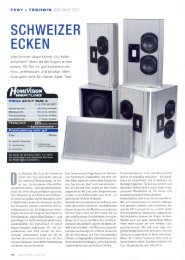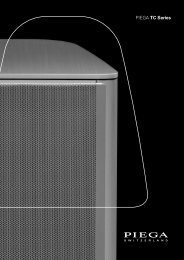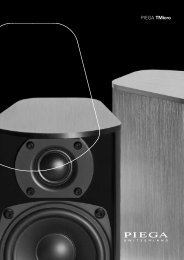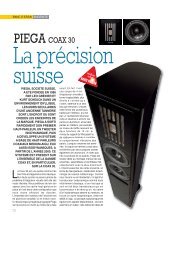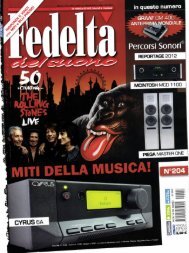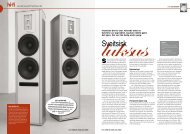You also want an ePaper? Increase the reach of your titles
YUMPU automatically turns print PDFs into web optimized ePapers that Google loves.
FocusPRODUCTSPEAKERSNestled against Lake Zurich, in <strong>the</strong><strong>to</strong>wn of Horgen, Switzerland,<strong>Piega</strong>’s headquarters gives <strong>the</strong>impression of a company in harmony withits environment. As you will see, <strong>Piega</strong> is,indeed, about as “Green” as a speakermanufacturer can be: No trees are killedin order <strong>to</strong> fabricate its cabinets. Foundedin 1986 by Leo Greiner and Kurt Scheuch,<strong>Piega</strong> has grown steadily <strong>to</strong> become <strong>the</strong>premier Swiss speaker manufacturer.Its goal from <strong>the</strong> beginning was <strong>to</strong> staytruthful <strong>to</strong> <strong>the</strong> music, <strong>to</strong> consider <strong>the</strong>speaker as a conduit of recorded soundfrom <strong>the</strong> concert hall or recording studio<strong>to</strong> <strong>the</strong> listening room. This ideal has beenpursued for over 20 years with technicalinnovation and precision craftsmanshipin <strong>the</strong> tradition of Swiss watchmakers.Transient speed was deemed <strong>to</strong> bean essential design goal—and why not?<strong>Music</strong>, after all, is all about transients,whose characteristic attack and decayhelp define an instrument’s timbre. Theevolution of an instrument’s harmonicenvelope is key <strong>to</strong> preserving its timbralrealism. (This effect can be easilydemonstrated by playing an audiotapeof a piano backwards, which causes <strong>the</strong>piano <strong>to</strong> be perceived as a pipe organ.)In pursuit of electrostatic sound qualityin a smaller package, <strong>Piega</strong> developed anew ribbon tweeter in 1986, and has sincestayed faithful <strong>to</strong> ribbon technology. In2000 <strong>Piega</strong> reached ano<strong>the</strong>r miles<strong>to</strong>newith <strong>the</strong> introduction of <strong>the</strong> world’s firstcoaxial-ribbon mid/tweeter driver. Theterm coaxial refers <strong>to</strong> a dual-elementdriver design in which <strong>the</strong> acousticalcenters of each driver element are spatiallyaligned, in contrast <strong>to</strong> a typical multiwaysystem where <strong>the</strong> tweeter and midrangeare spaced apart on <strong>the</strong> front baffle. At<strong>the</strong> crossover frequency in <strong>the</strong> uppermidrange, a wavelength is on <strong>the</strong> orderof six inches—or roughly <strong>the</strong> spacingbetween <strong>the</strong> drivers’ acoustic centers.Why is that a big deal, you ask? Because<strong>the</strong> summed output of <strong>the</strong> drivers in<strong>the</strong> crossover region is subject <strong>to</strong> waveinterference. There is usually an axis onwhich <strong>the</strong> combined frequency response<strong>Piega</strong> TC 10 X Loudspeaker<strong>Truthful</strong> <strong>to</strong><strong>the</strong> <strong>Music</strong>Dick Olsherof <strong>the</strong> drivers is pretty uniform. But move<strong>the</strong> measurement microphone a coupleof inches off axis, and you discoverconsiderable output cancellation. Mappedout in 3-D, speaker output in this regionwould be seen <strong>to</strong> exhibit lobes—hot andcold spots of sound-pressure level. Ofcourse, manufacturers are adept at putting<strong>the</strong>ir best feet forward, and officiallypublishedresponse curves usually presenta best-case scenario. However, at <strong>the</strong>listening seat, such a speaker is unlikely<strong>to</strong> image well, as small head movementsmodify perceived response.During <strong>the</strong> 1970s Sigfried Linkwitzwas <strong>the</strong> first <strong>to</strong> analyze and developa crossover network <strong>to</strong>pology thatexplicitly accounted for non-coincidentacoustic centers. Prior <strong>to</strong> that, traditionalcrossover networks assumed that alldrivers shared a common acoustic origin.And while <strong>the</strong> Linkwitz-Riley networkrepresents a step in <strong>the</strong> right direction,in <strong>the</strong> final analysis, <strong>the</strong>re is no substitutefor a successful coaxial design. The <strong>Piega</strong>coaxial ribbon driver is a case in point. Theflat midrange foil membrane surrounds acentrally located tweeter ribbon, lockingboth drivers’ acoustic centers in <strong>the</strong> samespatial location and resulting in uniformphase response across <strong>the</strong> crossoverregion. The midrange foil, only 0.02millimeters thick, is driven over its entirearea by neodymium magnets in pushpullfashion—<strong>the</strong> ideal “force over area”drive principle. Strictly speaking, <strong>the</strong>midrange is a magne<strong>to</strong>static planar driver,analogous <strong>to</strong> an electrostatic, except thatmagnetic ra<strong>the</strong>r than electrostatic force isused <strong>to</strong> move <strong>the</strong> diaphragm. The tweeterribbon element is embossed and mountedstrain-free on all four sides <strong>to</strong> ensuredamping of longitudinal bending waves.The ribbon kicks in around 3.5kHz, and<strong>the</strong> entire assembly covers <strong>the</strong> frequencyrange from about 400Hz <strong>to</strong> 50kHz.A small version of this coaxial driver(model C2) is used in <strong>the</strong> TC 10 X, and inall o<strong>the</strong>r <strong>Piega</strong> models denoted with <strong>the</strong>letter “X.” No doubt about it, <strong>the</strong> coaxialribbon driver is a high-tech product, said<strong>to</strong> take up <strong>to</strong> four hours of painstakingcraftsmanship <strong>to</strong> build under controlledenvironmental conditions.When it comes <strong>to</strong> cabinetry, <strong>Piega</strong>also follows <strong>the</strong> road less traveled.Whereas most manufacturers start withan “industry standard” MDF cabinet and<strong>the</strong>n work hard <strong>to</strong> control flexure, <strong>Piega</strong>cuts right through <strong>the</strong> Gordian Kno<strong>to</strong>f <strong>the</strong> traditional cabinet resonances78 November 2007 The Absolute Sound
juice up apparent detail, and very fewaudiophiles complain about <strong>to</strong>o muchbass. The <strong>Piega</strong>, on <strong>the</strong> o<strong>the</strong>r hand,bucked this trend and offered almost nopersonality of its own. First impressionwas of a seamless presentation. Inparticular, <strong>the</strong> midrange-presenceregionboundary, a troublesome spotfor conventional tweeters crossed overaround 3kHz, blended beautifully. Themusic’s character remained unchangedover <strong>the</strong> bandwidth of <strong>the</strong> coaxialdriver, with never a hint of brightnessor dissonance despite its extended treblerange. Soprano upper registers and violinover<strong>to</strong>nes soared naturally and delicately,unencumbered by dis<strong>to</strong>rtion products orresonances. As you can imagine, heavilyprocessed multitrack recordings greatlybenefited from <strong>the</strong> <strong>Piega</strong>’s squeaky-cleancharacter. The ability <strong>to</strong> negotiate poorrecordings gracefully is a major bonus forall of us whose record collections spanmuch more than a sanitized subset ofaudiophile recordings.The core of <strong>the</strong> midrange was renderedwith crystalline clarity, allowing <strong>to</strong>necolors, textures, and low-level detail <strong>to</strong>be resolved with disarming naturalness.Complex passages were readily clarifiedand with a masterful sense of speedand transient control that—well, I have<strong>to</strong> agree with <strong>the</strong> advertising copy—iselectrostatic in character. Dynamicswere closely tied <strong>to</strong> <strong>the</strong> choice ofamplification.The <strong>Piega</strong>disappeared betterthan any conventionaltwo-wayAround 100Wpc seemed <strong>to</strong> produce<strong>the</strong> most convincing reproduction of anorchestral crescendo. James Bongiorno’saffordable Son of Ampzilla 200 did aparticularly noteworthy job partnering<strong>the</strong> <strong>Piega</strong>, <strong>the</strong> combination being smooth,sweet, and dynamic. This is not <strong>to</strong> saythat more expensive amplifiers were alost cause with <strong>the</strong> <strong>Piega</strong>. Au contraire,<strong>the</strong> ultra-high-end Silicon Arts DesignZL-120 was clearly higher in resolutionthrough <strong>the</strong> lower midrange.I’ve left <strong>the</strong> best for last. Forget Britishmini-moni<strong>to</strong>rs—this is <strong>the</strong> new champwhen it comes <strong>to</strong> pinpoint imagingprecision and stability. I’m sure that itssuperb driver integration and coherencethrough <strong>the</strong> critical mids and upperoctaves play a major role in its imagingprowess. Wide, spacious, and slightly laidback,<strong>the</strong> soundstage was populated withimages etched with laser-like precision.Massed voices were readily resolvedand <strong>the</strong> impression of an organic space,completely independent of <strong>the</strong> speakers,was remarkably strong. And, yes, <strong>the</strong> <strong>Piega</strong>performed <strong>the</strong> proverbial disappearingact better than any conventional two-waymini-moni<strong>to</strong>r I’ve auditioned <strong>to</strong> date, andlet’s not forget that this is a three-wayspeaker. Bravo!Detailed, yet relaxed, <strong>the</strong> <strong>Piega</strong> is able<strong>to</strong> caress musical lines with speed, finesse,and no artificial aftertaste. A hard dayin <strong>the</strong> office? Park yourself in front of<strong>the</strong> <strong>Piega</strong>, kick off your shoes, and pouryourself a glass of wine. The <strong>Piega</strong> TC10 X loudspeaker represents <strong>the</strong> perfecttransportation <strong>to</strong> a higher dimension ofmusical enjoyment. TASThe Absolute Sound November 2007 81






